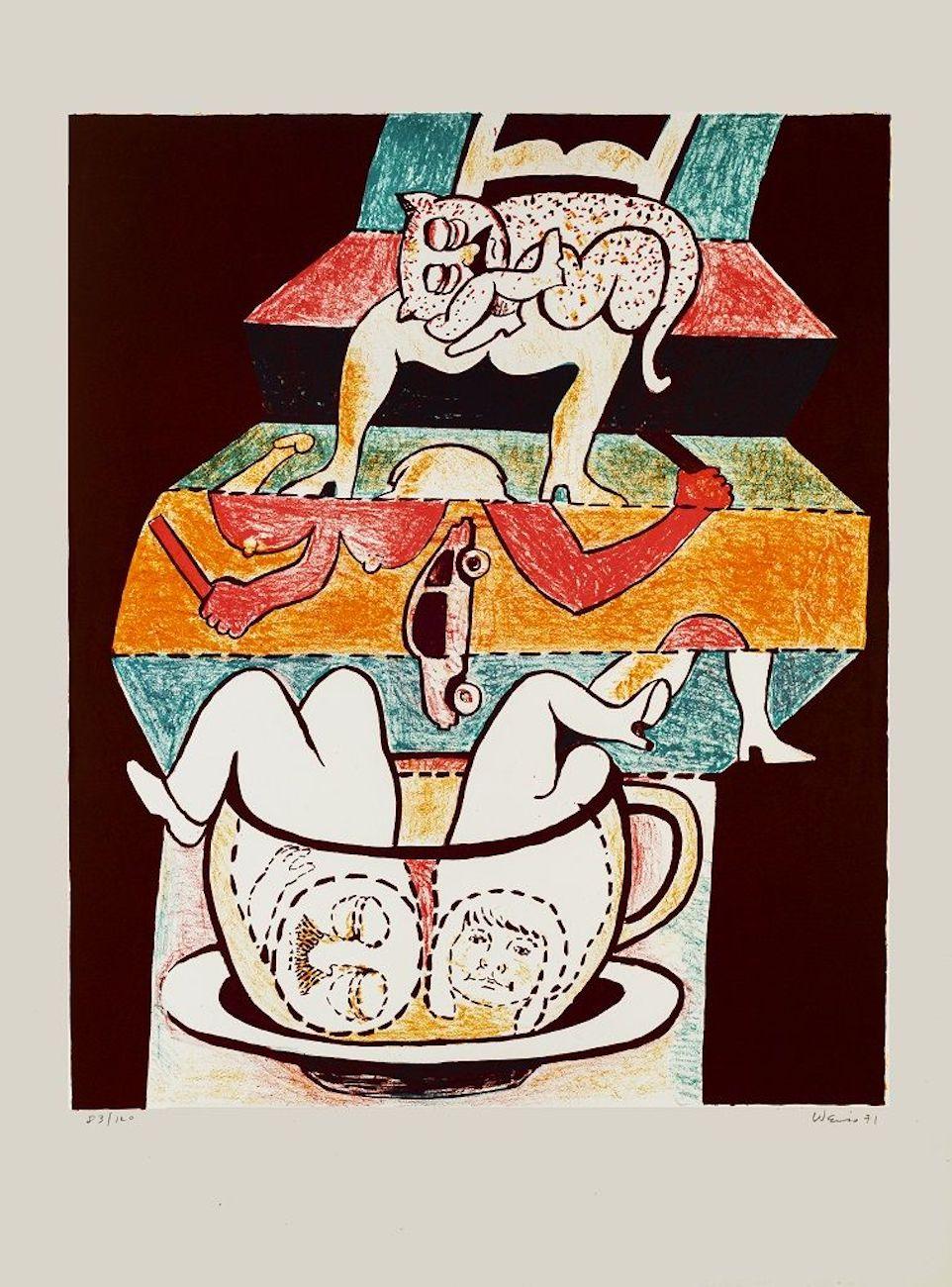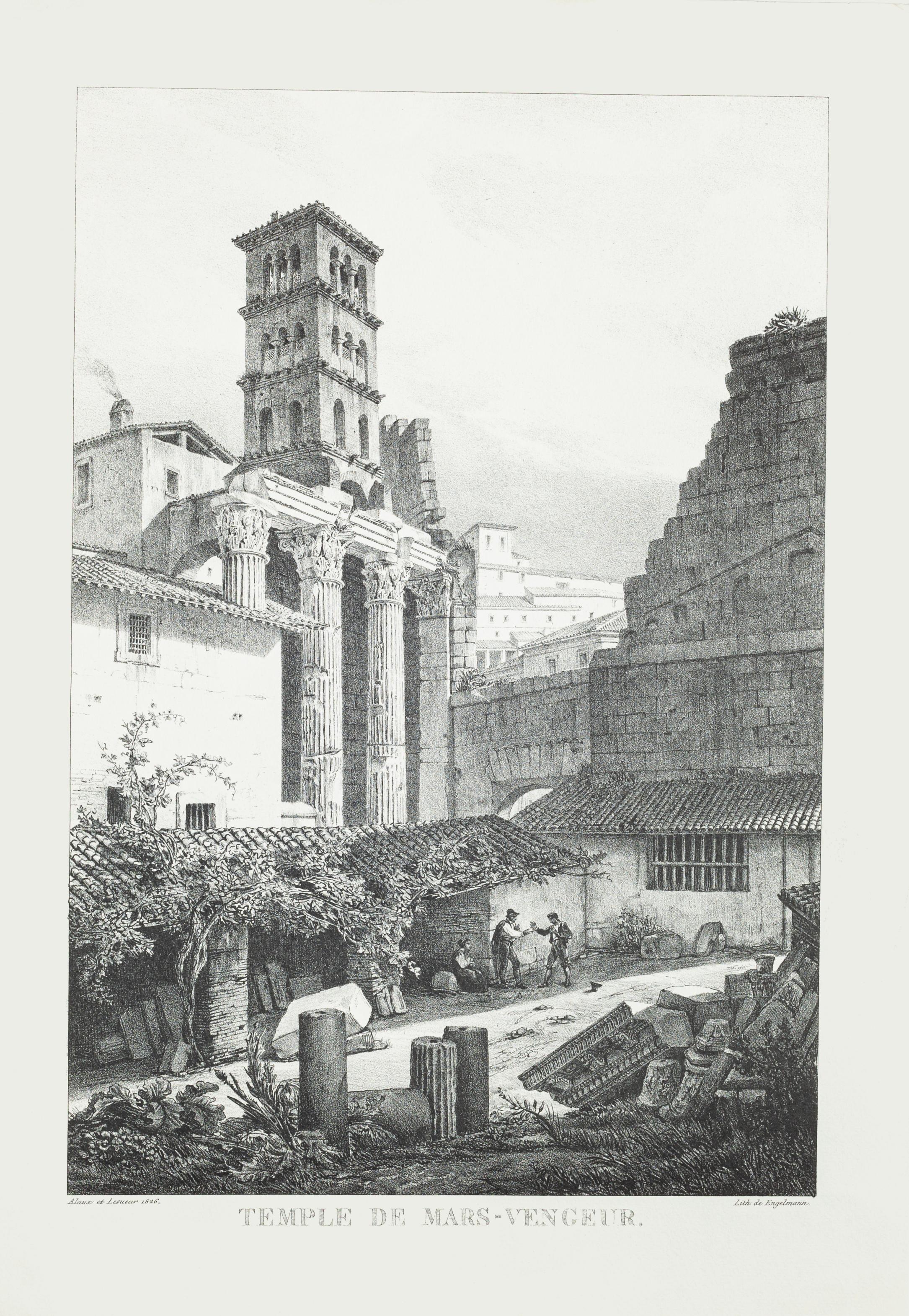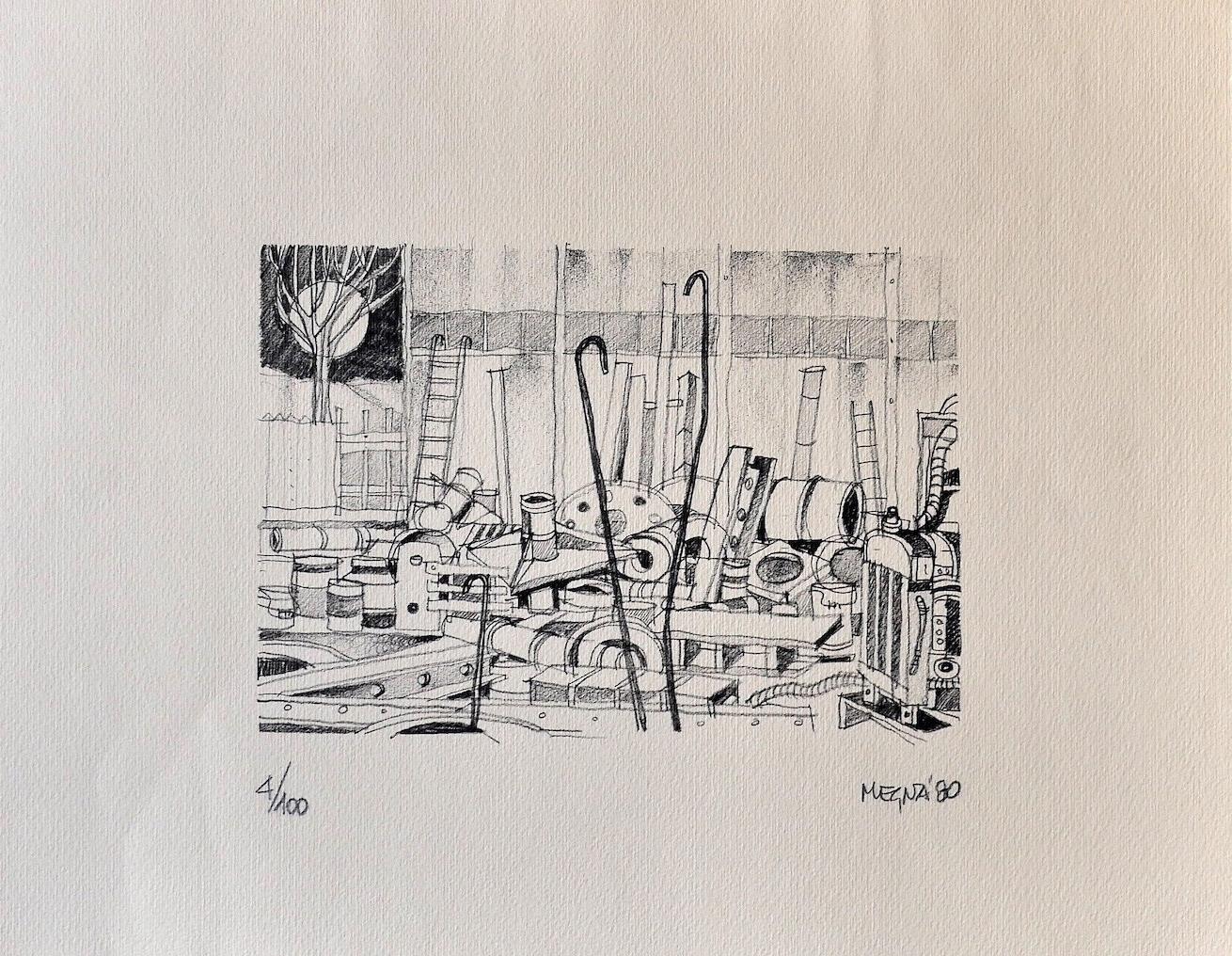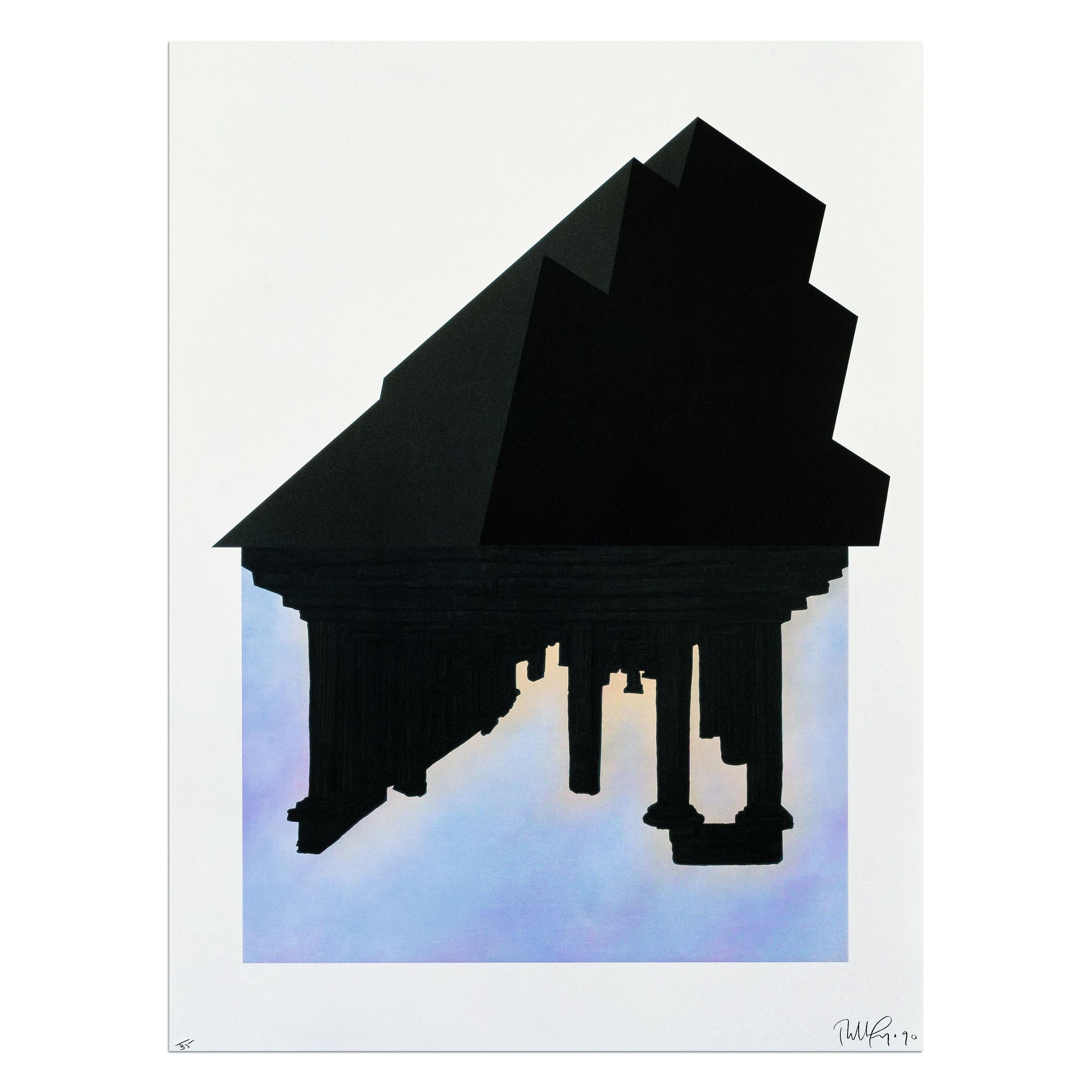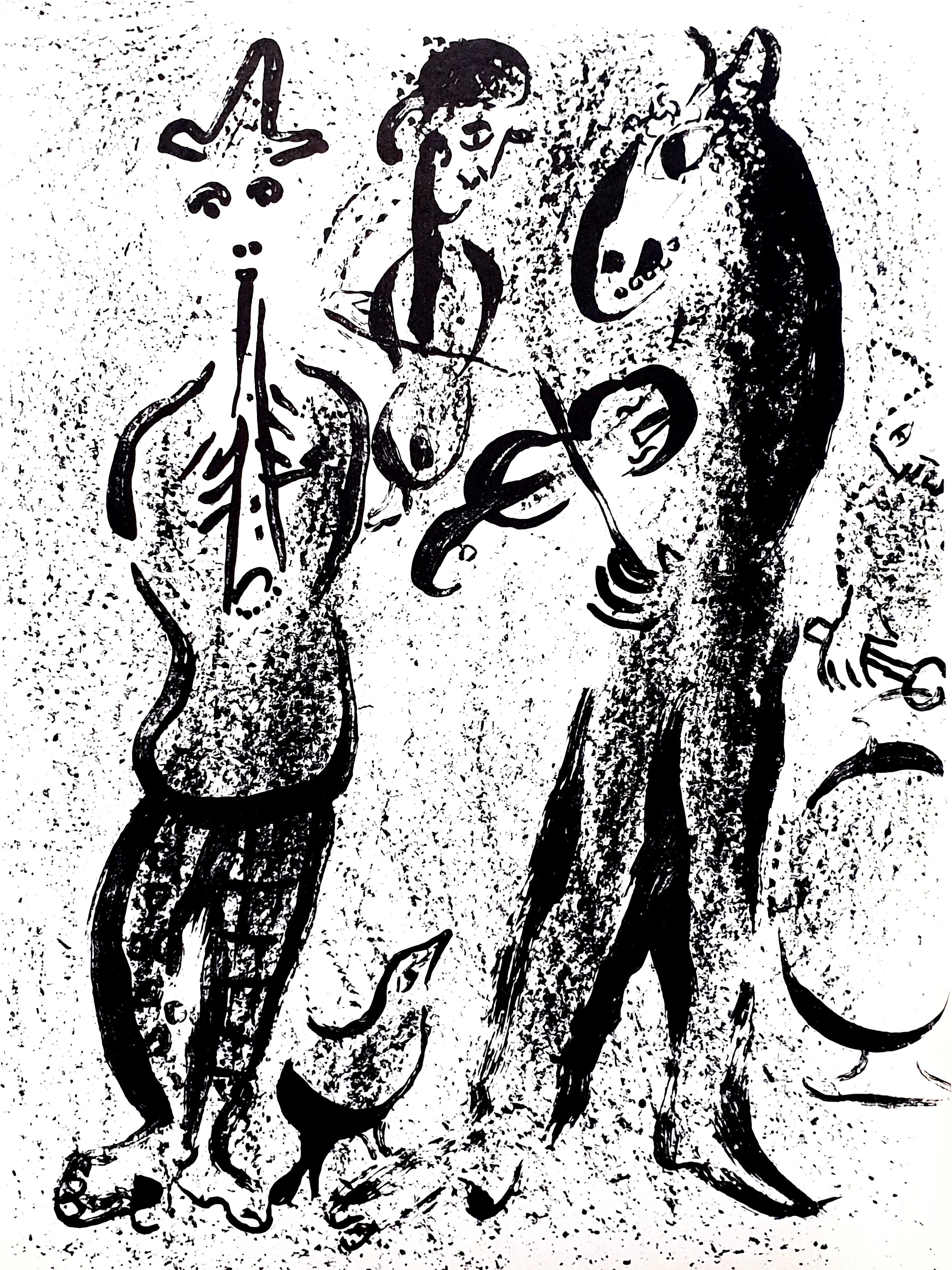Marc ChagallEve Incurs God's Displeasure, from Drawings for the Bible1960
1960
About the Item
- Creator:Marc Chagall (1887 - 1985, French)
- Creation Year:1960
- Dimensions:Height: 14.375 in (36.52 cm)Width: 10.25 in (26.04 cm)
- Medium:
- Period:
- Framing:Framing Options Available
- Condition:
- Gallery Location:Washington, DC
- Reference Number:
Marc Chagall
Described by art critic Robert Hughes as "the quintessential Jewish artist of the twentieth century," the Russian-French modernist Marc Chagall worked in nearly every artistic medium. Influenced by Symbolism, Fauvism, Cubism and Surrealism, he developed his own distinctive style, combining avant-garde techniques and motifs with elements drawn from Eastern European Jewish folk art.
Born Moishe Segal in 1887, in Belarus (then part of the Russian empire), Chagall is often celebrated for his figurative paintings, but he also produced stained-glass windows for the cathedrals of Reims and Metz, in France; for the United Nations, in New York; and for the Hadassah Hospital in Jerusalem, as well as book illustrations, stage sets, ceramics, tapestries and fine-art prints. Characterized by a bold color palette and whimsical imagery, his works are often narrative, depicting small-village scenes and quotidian moments of peasant life, as in his late painting The Flight into Egypt from 1980.
Before World War I, Chagall traveled between St. Petersburg, Paris and Berlin. When the conflict broke out, he returned to Soviet-occupied Belarus, where he founded the Vitebsk Arts College before leaving again for Paris in 1922. He fled to the United States during World War II but in 1947 returned to France, where he spent the rest of his life. His peripatetic career left its mark on his style, which was distinctly international, incorporating elements from each of the cultures he experienced.
Marc Chagall remains one of the past century’s most respected talents — find his art on 1stDibs.
- ShippingRetrieving quote...Ships From: Washington, DC
- Return PolicyA return for this item may be initiated within 7 days of delivery.
- The House in My Village, from 1960 Mourlot Lithographe IBy Marc ChagallLocated in Washington, DCArtist: Marc Chagall Title: The House in My Village Portfolio: Mourlot Lithographe I Medium: Lithograph Year: 1960 Edition: Unnumbered Framed Size: 21 7/8" x 18 7/8" Image Size: 12 1...Category
1960s Modern Figurative Prints
MaterialsLithograph
- 1977 Presidential Inauguration, from Inaugural ImpressionsBy Robert RauschenbergLocated in Washington, DCArtist: Robert Rauschenberg Title: 1977 Presidential Inauguration Portfolio: Inaugural Impressions Medium: Lithograph Date: 1977 Edition: 51/100 Frame Size: 36 1/2" x 26 1/2" Sheet S...Category
1970s Pop Art Figurative Prints
MaterialsLithograph
- Untitled, from 1977 Inaugural ImpressionsBy Jamie WyethLocated in Washington, DCArtist: Jamie Wyeth Title: Untitled Portfolio: Inaugural Impressions Medium: Lithograph in colors Date: 1977 Edition: 51/100 Sheet Size: 23" x 20" Image Size: 17" x 14" Signature: Ha...Category
1970s Pop Art Figurative Prints
MaterialsLithograph
- Woman Circus RiderBy Marc ChagallLocated in Washington, DCArtist: Marc Chagall Title: Woman Circus Rider Portfolio: Derriere le Miroir: 10 Ans d'Edition Medium: Lithograph Date: 1956 Edition: 2000 Frame Size: 21" x 27 1/2" Sheet Size: 14" x...Category
1950s Modern Figurative Prints
MaterialsLithograph
- Avenue De La Victoire at Nice, from Nice and the Cote d'AzurBy (after) Marc ChagallLocated in Washington, DCArtist: Marc Chagall (after) Title: Avenue De La Victoire at Nice Portfolio: Nice and the Cote d'Azur Medium: Lithograph Date: 1967 Edition: LXIII/LXXV Frame Size: 37 1/2" x 30 1/4" ...Category
1960s Figurative Prints
MaterialsLithograph
- Tamar, Daughter-in-Law of JudahBy Marc ChagallLocated in Washington, DCArtist: Marc Chagall Title: Tamar, Daughter-in-Law of Judah Portfolio: Drawings for the Bible Medium: Lithograph Date: 1960 Edition: Unnumbered Sheet Size: 14 3/8" x 10 1/4" Image Si...Category
1960s Figurative Prints
MaterialsLithograph
- Breakdown Figures - Original Lithograph by Hugh Weiss - 1971By Hugh WeissLocated in Roma, ITBreakdown Figures is an original colored lithograph realized by Hugh Weiss in 1971. Hand-signed and dated by the artist on the lower right corner. Numbered on the lower-left corner (83/120). The artwork represents a very funny composition with different breakdown figures: a couple dipped upside down in a giant cup...Category
1970s Contemporary Figurative Prints
MaterialsLithograph
- Temple of Mars - Offset on Paper by G. Engelmann - 1826By G. EngelmannLocated in Roma, ITTemple of Mars is offset print artwork on paper, realized by G. Engelmann in 1826, the artwork is signed on the plate and dated. In very good condition. The artwork represents the roman landscape of the temple of Mars, The temple of Mars in the Circus was a temple of ancient Rome dedicated to Mars, located near the Circus Flaminio, in the IX Augustan region. the temple contained a colossal statue of...Category
1820s Figurative Prints
MaterialsLithograph
- Workshop - Original Lithograph by Giuseppe Megna - 1980 ca.By Giuseppe MegnaLocated in Roma, ITWorkshop is an original lithograph on paper realized by Giuseppe Megna in 1980 ca. Hand-signed on the lower right and dated, numbered on the lower left in pencil, edition of 4/100 p...Category
1980s Figurative Prints
MaterialsLithograph
- Robert Longo, Black Palms - Lithograph from 1989, Signed PrintBy Robert LongoLocated in Hamburg, DERobert Longo (American, born 1953) Black Palms, 1989 Medium: Lithograph on rag paper Dimensions: 169 x 127 cm (66½ x 50 in) Edition of 35: Hand-signed and numbered Condition: ExcellentCategory
20th Century Contemporary Figurative Prints
MaterialsLithograph
- STREET SCENE Signed Lithograph, NYC Crowd Portrait Pencil Drawing, A-Line SkirtsBy Raphael SoyerLocated in Union City, NJSTREET SCENE, NYC Crowd, is an original, hand drawn lithograph by Raphael Soyer, the renowned Russian-born American realist painter, draftsman, and printmaker. Printed using traditio...Category
1970s Realist Figurative Prints
MaterialsLithograph
- Marc Chagall - Original LithographBy Marc ChagallLocated in Collonge Bellerive, Geneve, CHMarc Chagall Original Lithograph 1963 Dimensions: 32 x 24 cm Reference: Chagall Lithographe 1957-1962. VOLUME II. Unsigned edition of over 5,000 Condition : Excellent Marc Chagall (born in 1887) Marc Chagall was born in Belarus in 1887 and developed an early interest in art. After studying painting, in 1907 he left Russia for Paris, where he lived in an artist colony on the city’s outskirts. Fusing his own personal, dreamlike imagery with hints of the fauvism and cubism popular in France at the time, Chagall created his most lasting work—including I and the Village (1911)—some of which would be featured in the Salon des Indépendants exhibitions. After returning to Vitebsk for a visit in 1914, the outbreak of WWI trapped Chagall in Russia. He returned to France in 1923 but was forced to flee the country and Nazi persecution during WWII. Finding asylum in the U.S., Chagall became involved in set and costume design before returning to France in 1948. In his later years, he experimented with new art forms and was commissioned to produce numerous large-scale works. Chagall died in St.-Paul-de-Vence in 1985. The Village Marc Chagall was born in a small Hassidic community on the outskirts of Vitebsk, Belarus, on July 7, 1887. His father was a fishmonger, and his mother ran a small sundries shop in the village. As a child, Chagall attended the Jewish elementary school, where he studied Hebrew and the Bible, before later attending the Russian public school. He began to learn the fundamentals of drawing during this time, but perhaps more importantly, he absorbed the world around him, storing away the imagery and themes that would feature largely in most of his later work. At age 19 Chagall enrolled at a private, all-Jewish art school and began his formal education in painting, studying briefly with portrait artist Yehuda Pen. However, he left the school after several months, moving to St. Petersburg in 1907 to study at the Imperial Society for the Protection of Fine Arts. The following year, he enrolled at the Svanseva School, studying with set designer Léon Bakst, whose work had been featured in Sergei Diaghilev's Ballets Russes. This early experience would prove important to Chagall’s later career as well. Despite this formal instruction, and the widespread popularity of realism in Russia at the time, Chagall was already establishing his own personal style, which featured a more dreamlike unreality and the people, places and imagery that were close to his heart. Some examples from this period are his Window Vitebsk (1908) and My Fianceé with Black Gloves (1909), which pictured Bella Rosenfeld, to whom he had recently become engaged. The Beehive Despite his romance with Bella, in 1911 an allowance from Russian parliament member and art patron Maxim Binaver enabled Chagall to move to Paris, France. After settling briefly in the Montparnasse neighborhood, Chagall moved further afield to an artist colony known as La Ruche (“The Beehive”), where he began to work side by side with abstract painters such as Amedeo Modigliani and Fernand Léger as well as the avant-garde poet Guillaume Apollinaire. At their urging, and under the influence of the wildly popular fauvism and cubism, Chagall lightened his palette and pushed his style ever further from reality. I and the Village (1911) and Homage to Apollinaire (1912) are among his early Parisian works, widely considered to be his most successful and representative period. Though his work stood stylistically apart from his cubist contemporaries, from 1912 to 1914 Chagall exhibited several paintings at the annual Salon des Indépendants exhibition, where works by the likes of Juan Gris, Marcel Duchamp and Robert Delaunay were causing a stir in the Paris art world. Chagall’s popularity began to spread beyond La Ruche, and in May 1914 he traveled to Berlin to help organize his first solo exhibition, at Der Sturm Gallery. Chagall remained in the city until the highly acclaimed show opened that June. He then returned to Vitebsk, unaware of the fateful events to come. War, Peace and Revolution In August 1914 the outbreak of World War I precluded Chagall’s plans to return to Paris. The conflict did little to stem the flow of his creative output, however, instead merely giving him direct access to the childhood scenes so essential to his work, as seen in paintings such as Jew in Green (1914) and Over Vitebsk (1914). His paintings from this period also occasionally featured images of the war’s impact on the region, as with Wounded Soldier (1914) and Marching (1915). But despite the hardships of life during wartime, this would also prove to be a joyful period for Chagall. In July 1915 he married Bella, and she gave birth to a daughter, Ida, the following year. Their appearance in works such as Birthday (1915), Bella and Ida by the Window (1917) and several of his “Lovers” paintings give a glimpse of the island of domestic bliss that was Chagall’s amidst the chaos. To avoid military service and stay with his new family, Chagall took a position as a clerk in the Ministry of War Economy in St. Petersburg. While there he began work on his autobiography and also immersed himself in the local art scene, befriending novelist Boris Pasternak, among others. He also exhibited his work in the city and soon gained considerable recognition. That notoriety would prove important in the aftermath of the 1917 Russian Revolution when he was appointed as the Commissar of Fine Arts in Vitebsk. In his new post, Chagall undertook various projects in the region, including the 1919 founding of the Academy of the Arts. Despite these endeavors, differences among his colleagues eventually disillusioned Chagall. In 1920 he relinquished his position and moved his family to Moscow, the post-revolution capital of Russia. In Moscow, Chagall was soon commissioned to create sets and costumes for various productions at the Moscow State Yiddish...Category
1960s Surrealist Figurative Prints
MaterialsLithograph
